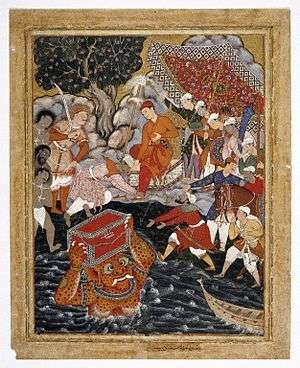Ifrit
 | |
| Grouping | Jinn |
|---|---|
| Region | Middle East |
Ifrit, efreet, efrite, ifreet, afreet, afrite and afrit (Arabic: ʻIfrīt: عفريت, pl ʻAfārīt: عفاريت) are supernatural creatures in some Middle Eastern stories.
Description
The Ifrits are in a class of infernal Jinn noted for their strength and cunning. An ifrit is an enormous winged creature of fire, either male or female, who lives underground and frequents ruins. Ifrits live in a society structured along ancient Arab tribal lines, complete with kings, tribes and clans. They generally marry one another, but they can also marry humans.
While ordinary weapons and forces have no power over them, they are susceptible to magic, which humans can use to kill them or to capture and enslave them.[1] As with other jinn, an ifrit may be either a believer or an unbeliever, good or evil, but it is most often depicted as a wicked and ruthless being.
Etymology

Traditionally, Arab philologists trace the derivation of the word to عفر (afara, "to rub with dust"). Some Western philologists, such as Johann Jakob Hess and Karl Vollers, attribute it to Middle Persian afritan which corresponds to Modern Persian آفريدن (to create).
Islamic scripture
An Ifrit is mentioned in the Qur'an, Sura An-Naml (27:38-40):
[Solomon] said, "O assembly [of jinn], which of you will bring me her [the Queen of Sheba] throne before they come to me in submission?" An ifrit (strong one) from the jinn said: "I will bring it to you before you rise from your place. And verily, I am indeed strong, and trustworthy for such work." One with whom was knowledge of the Scripture said: "I will bring it to you within the twinkling of an eye!" Then when Solomon saw it placed before him, he said: "This is by the Grace of my Lord - to test me whether I am grateful or ungrateful! And whoever is grateful, truly, his gratitude is for (the good of) his own self; and whoever is ungrateful, (he is ungrateful only for the loss of his own self). Certainly my Lord is Rich (Free of all needs), Bountiful."
Arabic literature
In One Thousand and One Nights, in a tale called "The Porter and the Young Girls", there is a narrative about a prince who is attacked by pirates and takes refuge with a woodcutter. The prince finds an underground chamber in the forest leading to a beautiful woman who has been kidnapped by an ifrit. The prince sleeps with the woman and both are attacked by the jealous ifrit, who changes the prince into an ape. Later a princess restores the prince and fights a pitched battle with the ifrit, who changes shape into various animals, fruit, and fire until being reduced to cinders. In the book the word is used interchangeably with genie and in the tale the spirit is malevolent but easily tricked by the protagonist.[2]
In early folklore, the ifrit is said to be formed from the blood of a murder victim. Driving an unused nail into the blood was supposed to stop their formation. The creatures were reported as being able to take the form of Satan, the murder victim, or even a sandstorm.[3]
See also
References
- ↑ "ifrit | Islamic mythology". Encyclopedia Britannica. Retrieved 2016-11-19.
- ↑ Leon Hale (January 13, 2002). "Arabic mythology is worth revisiting". Houston Chronicle.
- ↑ "Aeromancy". The Element Encyclopedia of the Psychic World. Harper Element. 2006. p. 10.